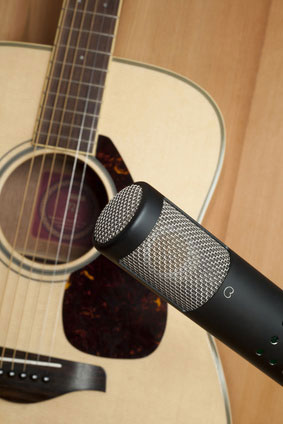 I record acoustic guitar a LOT. It’s my primary instrument and features in 99% of all my recordings. So I’ve learned some tricks along the way for getting a great acoustic guitar sound. But that doesn’t mean I can’t learn some new ones.
I record acoustic guitar a LOT. It’s my primary instrument and features in 99% of all my recordings. So I’ve learned some tricks along the way for getting a great acoustic guitar sound. But that doesn’t mean I can’t learn some new ones.
Björgvin Benediktsson just wrote an article with his top ten tips for recording acoustic guitar. Most of them I already do. Some I’ve never tried – putting a mic at the first fret is one of those. I’d like to add a couple of things to his list.
One of his tips is to “record in stereo,” by which he means recording with either a stereo microphone or with two microphones in a stereo configuration, such as the “coincident pair,” which means that two mics are placed with their capsules as close together as possible, but angled differently toward the guitar. And that is a fantastic way to get a stereo sound. But I would like to add the way I do it – which is basically “fake stereo” but doesn’t require you to have two mics or a stereo mic. You just record the guitar part once. Then on a second track, record the SAME part (meaning play it again!) again. Then pan the two parts left and right. The differences in the way you play the part will be enough to give you a great, full, wide guitar sound.
This was actually on Björgvin’s list under his tip for using different mics for double-tracking, which is the more formal term for doing my fake stereo thing. But his point was more for the added variety of sound when using two different mics rather than on using double-tracking as another way to achieve stereo.
One other tip I would add to his list is to pay very close attention to where the mic is pointing on your guitar, as well as the angle and distance. Make a note of it. Memorize it. This is because you will often need to stop a recording to do extra takes. And if anything is different, the angle, where the mic is pointing, etc. you will get a very different sound, which you do not want (unless you’re going for something whacky) on a single guitar track. It will sound jarring and just plain bad. So when doing additional takes, be sure to maintain the mic in relation to the guitar. Then double-check the consistency of the tone by listening through the transition from first take to second. I recently had to re-record an entire acoustic guitar track because I didn’t remember how I recorded the original days earlier, and I just could not duplicate the tone. Save yourself the time and effort by noting the details, and if possible, record the entire track on the same day in the same session. Of course, doing it all in one take is preferable.). Shya. Good luck with that.
Here is Björgvin’s article: http://audio-issues.com/recording-tips/top-ten-methods-for-recording-acoustic-guitar/#axzz2UJg6eXtR
nice video, i am trying to get the best sound out of my acoustic. although i do not have the recording quality microphone, the second method worked great for me. one question, how do you get the fuzz out of the recording?
Gavin,
IF you’re getting “fuzz” in your recording, it is likely you are distorting your audio interface by overloading it. Try turning down all the inputs until you see no “red” in any of the meters and record again. That should do the trick.
Ken